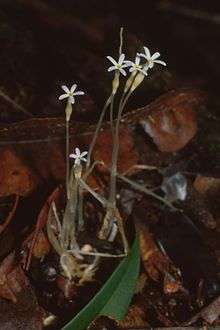Voyria
| Voyria | |
|---|---|
 | |
| Voyria tenella | |
| Scientific classification | |
| Kingdom: | Plantae |
| (unranked): | Angiosperms |
| (unranked): | Eudicots |
| (unranked): | Asterids |
| Order: | Gentianales |
| Family: | Gentianaceae |
| Genus: | Voyria L. |
| Species | |
|
See text | |
Voyria, the ghostplants,[1] is a genus of nineteen species of herbaceous perennial plants, belonging to the family Gentianaceae. They are mostly native to warm temperate and tropical regions of Central America and South America with one species occurring in the Everglades of Florida.
Unlike most plants, they do not contain chlorophyll; they are myco-heterotrophs, getting their food through parasitism upon fungi rather than photosynthesis. Their roots are thick and densely clustered forming a "birds nest" that house their fungus host. The flowers can be single or held in corymbs of many individual flowers depending on species. The stems are usually pallid in colour with reduced scale-like foliage though the flowers can vary in colour with white or yellow predominating but blue and pink also occurring. Like all myco-heterotrophs they are capable of living in very dark conditions, such as the floor of deep forests, because they no longer derive energy from sunlight.
- Species
- Voyria aphylla
- Voyria caerulea
- Voyria clavata
- Voyria corymbosa
- Voyria parasitica
- Voyria parviflora
- Voyria rosea
- Voyria spruceana
- Voyria tenella
- Voyria tenuiflora
- Voyria truncata
References
- ↑ "Voyria". Natural Resources Conservation Service PLANTS Database. USDA. Retrieved 6 August 2015.